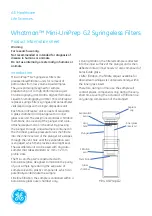
System Sizing for Swimming Pools
System Sizing
Use these three formulas to calculate the volume of water in the pool/spa:
Rectangular Pool:
Length(M) x Width(M) x Average Depth(M) x1000 = Total Litres
Oval / Round Pool:
Diameter (M) x Diameter (M) x Average Depth (M) x 790 = Total Litres
Free Form Pool:
Average Length (M) x Average Width (M) x Average Depth (M) x 1000 = Total Litres
CRISTAL MAGIC System Production Capacity
IMPORTANT CONCEPTS
1 . Purifier Demand / Pool Requirements
The rate at which purifier is consumed in any swimming pool depends on the relationship of eight major
variables. Since these variables can vary widely from pool to pool and season to season, precise prediction of
the purifier
demand
for
any one pool is difficult. At the end of this section, rules of thumb are provided for
CRISTAL MAGIC System Sizing.
THE VARIABLES ARE:
1. Volume and surface area of the pool /spa being purified.
2.
Average water temperature maintained: As the temperature of the water increases, the purifier
demand
will
also increase. As the temperature of the water decreases, the purifier
demand will
also decrease.
When this happens, the output dial should
be decreased to compensate for this lower
demand
(which
will also protect your equipment from excessive levels of purifiers).
3. Cyanuric acid level
maintained: This chemical, when added to pool water, significantly inhibits purifier
depletion from exposure to sunlight. Cyanuric acid also inhibits corrosion if your pool is equipped with any
metal components. Minimum levels or better must be maintained to ensure that the purifier being
produced is protected from UV breakdown.
4. Bather load: As the bather load increases, the purifier
demand
will also increase.
5.
Amount of direct sunlight / UV exposure: Pools exposed to larger amounts of direct sunlight are more
vulnerable to increased purifier loss and algae growth. Indoor or screened pools have less purifier
demand
.
6.
Exposure to vegetation and airborne debris: Dense landscaping near the pool, along with increased
nitrate levels (urine, bird droppings, fertilizer, well water, etc.) greatly contribute to increased purifier
demand
.
7.
Chemical dilution: Virtually all pool chemicals experience dilution through rainfall, adding of fresh
make-up water due to evaporation, splash -out, filter backwashing, leaks, etc. When freshwater is
added, purifier
demand
increases for a brief period.
8.
Main filter pump runtime and your pool's circulation patterns: Purifier can only be produced while the
main filter pump is operating. Waterfalls/Fountains and other water features operated by the filter pump
can directly effect purifier
demand.
The main filter pump runtime and/or output dial may need to be
increased to satisfy this higher
demand.
Section 1 a
3
Summary of Contents for 27316
Page 25: ......








































